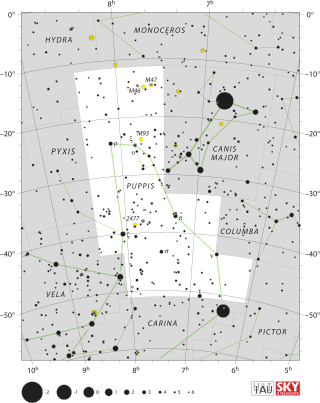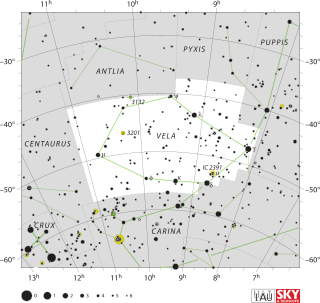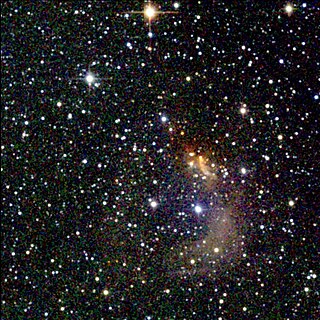
Argo Navis, or simply Argo, is one of Ptolemy's 48 constellations, now a grouping of three IAU constellations. It is formerly a single large constellation in the southern sky. The genitive is "Argus Navis", abbreviated "Arg". Flamsteed and other early modern astronomers called it Navis, genitive "Navis", abbreviated "Nav".

A Bayer designation is a stellar designation in which a specific star is identified by a Greek or Latin letter followed by the genitive form of its parent constellation's Latin name. The original list of Bayer designations contained 1,564 stars. The brighter stars were assigned their first systematic names by the German astronomer Johann Bayer in 1603, in his star atlas Uranometria. Bayer catalogued only a few stars too far south to be seen from Germany, but later astronomers supplemented Bayer's catalog with entries for southern constellations.

Carina is a constellation in the southern sky. Its name is Latin for the keel of a ship, and it was the southern foundation of the larger constellation of Argo Navis until it was divided into three pieces, the other two being Puppis, and Vela.

Puppis is a constellation in the southern sky. It was originally part of the traditional constellation of Argo Navis, which was divided into three parts, the other two being Carina, and Vela. Puppis is the largest of the three constellations in square degrees. It is one of the 88 modern constellations recognized by the International Astronomical Union.

Vela is a constellation in the southern sky, which contains the Vela Supercluster. Its name is Latin for the sails of a ship, and it was originally part of a larger constellation, the ship Argo Navis, which was later divided into three parts, the others being Carina and Puppis. With an apparent magnitude of 1.8, its brightest star is the hot blue multiple star Gamma Velorum, one component of which is the closest and brightest Wolf-Rayet star in the sky. Delta and Kappa Velorum, together with Epsilon and Iota Carinae, form the asterism known as the False Cross. 1.95-magnitude Delta is actually a triple or quintuple star system.

In contemporary astronomy, 88 constellations are recognized by the International Astronomical Union (IAU). Each constellation is a region of the sky bordered by arcs of right ascension and declination, together covering the entire celestial sphere. Their boundaries were officially adopted by the International Astronomical Union in 1928 and published in 1930.

Omicron Velorum is a star in the constellation Vela. It is the brightest member of the loose naked eye open cluster IC 2391, also known as the ο Velorum Cluster.

Pi Puppis, Latinized from π Puppis, also named Ahadi, is the second-brightest star in the southern constellation of Puppis. It has an apparent visual magnitude of 2.733, so it can be viewed with the naked eye at night. Parallax measurements yield an estimated distance of roughly 810 light-years from the Earth. This is a double star with a magnitude 6.86 companion at an angular separation of 0.72 arcsecond and a position angle of 148° from the brighter primary.

Former constellations are old historical Western constellations that for various reasons are no longer widely recognised or are not officially recognised by the International Astronomical Union (IAU). Prior to 1930, many of these defunct constellations were traditional in one or more countries or cultures. Some only lasted decades but others were referred to over many centuries. All are now recognised only for having classical or historical value. Many former constellations had complex Latinised names after objects, people, or mythological or zoological creatures. Others with unwieldy names were shortened for convenience. For example, Scutum Sobiescianum was reduced to Scutum, Mons Mensae to Mensa, and Apparatus Sculptoris to Sculptor.

The Vela supernova remnant is a supernova remnant in the southern constellation Vela. Its source Type II supernova exploded approximately 11,000 years ago. The association of the Vela supernova remnant with the Vela pulsar, made by astronomers at the University of Sydney in 1968, was direct observational evidence that supernovae form neutron stars.
Markeb is the proper name for some stars.

k Puppis is a Bayer designation given to an optical double star in the constellation Puppis, the two components being k1 Puppis and k2 Puppis.

Constellation families are collections of constellations sharing some defining characteristic, such as proximity on the celestial sphere, common historical origin, or common mythological theme. In the Western tradition, most of the northern constellations stem from Ptolemy's list in the Almagest, and most of the far southern constellations were introduced by sailors and astronomers who traveled to the south in the 16th to 18th centuries. Separate traditions arose in India and China.
Gould designations for stars are similar to Flamsteed designations in the way that they number stars within a constellation in increasing order of right ascension. Each star is assigned an integer, followed by " G. ", and then the Latin genitive of the constellation it lies in. See 88 modern constellations for a list of constellations and the genitive forms of their names.

Omicron Puppis (ο Puppis) is candidate binary star system in the southern constellation of Puppis. It is visible to the naked eye, having a combined apparent visual magnitude of +4.48. Based upon an annual parallax shift of 2.30 mas as seen from Earth, it is located roughly 1,400 light years from the Sun.

The southern celestial hemisphere, also called the Southern Sky, is the southern half of the celestial sphere; that is, it lies south of the celestial equator. This arbitrary sphere, on which seemingly fixed stars form constellations, appears to rotate westward around a polar axis as the Earth rotates.

Vela Molecular Ridge is a molecular cloud complex in the constellations Vela and Puppis. Radio 12CO observations of the region showed the ridge to be composed of several clouds, each with masses 100,000–1,000,000 M☉. This cloud complex lies on the sky in the direction of the Gum Nebula (foreground) and the Carina–Sagittarius Spiral Arm (background). The most important clouds in the region are identified by the letters A, B, C and D, and in fact belong to two different complexes: the clouds A, C and D are located at an average distance of about 700-1000 parsecs and are related to the OB association Vela R2, while cloud B is located at a greater distance, up to 2000 parsecs away, and is physically connected to the extended Vela OB1 association.